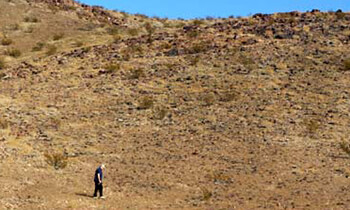Mojave National Preserve
Kelso Dunes
General Info | Maps | Description | Things to Do | Camping/Lodging | Nearby

This unique and isolated dune system rises more than 600 feet above the desert floor. The dunes were created by southeast winds blowing finely grained residual sand from the Mojave River sink, which lies to the northwest. The dunes' color is created from many golden rose quartz particles. When the dry sand grains slide down the steep upper slopes, a notable booming sound is produced. In some years, the dunes offer a nice spring wildflower display. A hike to the top and back takes approximately two hours. The area is closed to vehicles.
Video on area
This extraordinary dune system has an unexpectedly mysterious history. Huge amounts of sand were needed to build Kelso’s delicate wind-created sculptures, but geologists studying the Preserve discovered that no new sand is moving in to replenish the dunes. Where did the sand originally come from? What made it stop accumulating? The Kelso Dune sands remained a mystery until very recently.
By studying the mineral composition and shapes of sand grains that make up Kelso Dunes, we know that most of the sand has traveled all the way from the Mojave River sink east of Afton Canyon. Wind blowing from the northwest gradually carried the sand southeastward. In the path of the prevailing winds lie the Providence Mountains and the pink pinnacles of the Granite Mountains. The rocky crags and sloping fans of the two ranges block the moving sand. Sand piles up at the base of the mountains and along their flanks, forming dunes and sand sheets.

Where the sand piles up researchers found that the dunes are actually made up of several sets of dunes, stacked one on top of another. Each set formed in response to some past climate change! The Kelso Dunes depend upon times when the sand grain (sediment) supply is enhanced. This happens whenever the climate is dry enough to expose the raw material of dunes, sand, to the wind. In fact, most of the eastern part of the Kelso Dunes formed when water-filled Soda Lake and Silver Lake dried up, exposing the lake bottom sediment. The entire dune system was stacked up in five major pulses over the past 25,000 years.

Plants move in:
Over the past few thousand years plants have progressively covered and stabilized areas once covered by drifting sand. As you explore the dunes look for tracks left behind by the many creatures that call these dunes home.
For a Book and Map of the area see our
Mohave Road guide
General Info| Maps | Description | Things to Do | Camping/Lodging | Nearby
Other locations to visit in Mojave Desert
Amboy Crater - Cinder Cones - Goffs - Hole in the Wall - Kelso Depot - Kelso Dunes - Mitchell Caverns
Share this page on Facebook:
The Desert Environment
The North American Deserts
Desert Geological Terms







